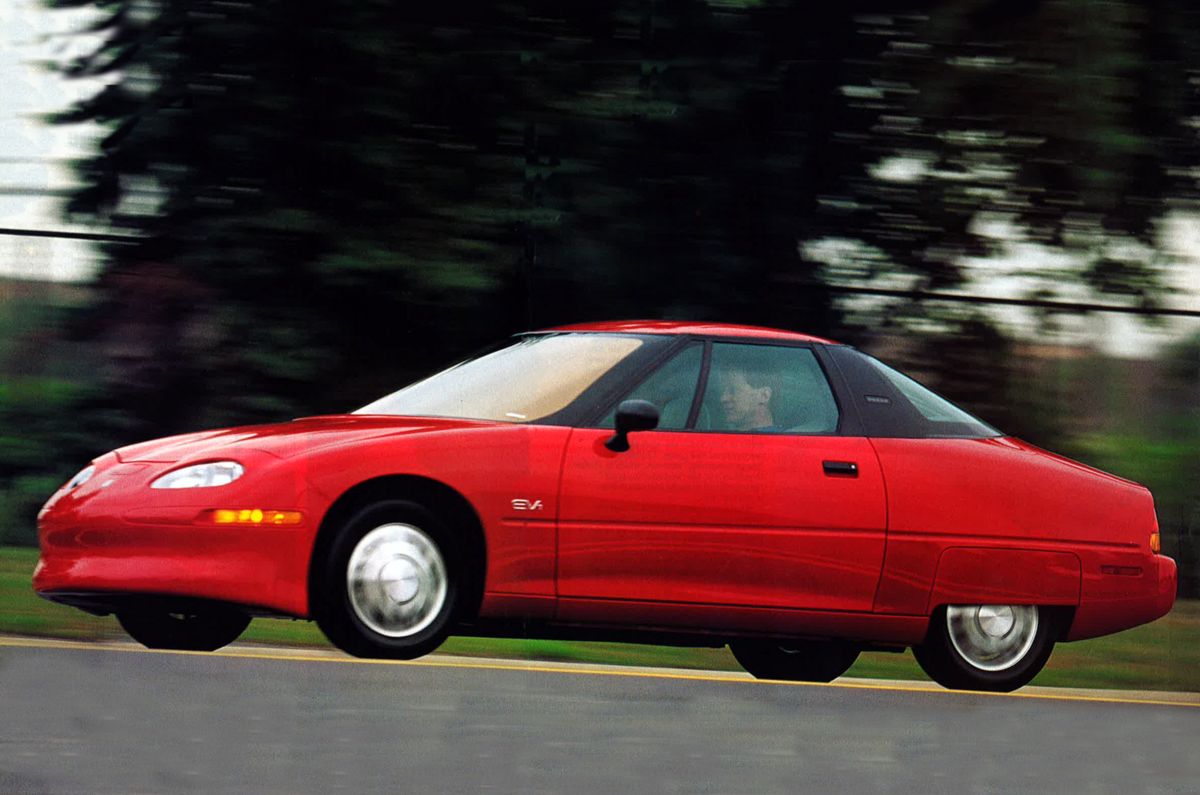Last month, electric and hybrid models experienced another jump in popularity, taking 5.2% of new car sales in the UK with 8244 registrations.
Most of those will be hybrids, admittedly, but electric vehicles (EVs) are no longer a rarity. This is astonishing, really, given that the first mass-market model, the Nissan Leaf, only went on sale in 2011.
Only 15 years before that came the first EV of the modern era, the aptly named General Motors EV1 – a car that was, in many respects, ahead of its time.
The EV1 began life in 1990 as the Impact two-seat coupé concept car. The reaction to the Impact was so positive that the California Air Resources Board went on to mandate that 2% of sales by major car manufacturers in the state needs to be electric by 1998. Thus development of a production model began.
 In April 1994, the 50 examples of the production Impact were issued to volunteers on a two-week loan. This scheme, named Preview, proved enormously popular but all examples of the car were recalled and destroyed at the end of the loans. Call it foreshadowing.
In April 1994, the 50 examples of the production Impact were issued to volunteers on a two-week loan. This scheme, named Preview, proved enormously popular but all examples of the car were recalled and destroyed at the end of the loans. Call it foreshadowing.
Development behind the scenes continued, resulting in an evolved version of the Impact, the EV1, that rolled out in 1996.
Exclusive to residents of California and Arizona, the EV1 was made available on a leasing programme with monthly fees of around $400 ($615 or £470 today). This was due to the fact that the car would have been unpalatably expensive to buy, with a mooted price of around $35,000 ($53,800 or £41,000 today).
On 28 August 1996, Autocar's John McCormick travelled to the US to evaluate this pioneer.
 "The EV1 is based on a stiff and light aluminium structure," we explained. "It's powered by one electric motor, a three-phase, 137bhp (102kW) AC induction motor that spins to 13,000rpm. It is integrated into a drive unit that contains a two-stage gear reduction and differential. The powertrain weights 68kg (150lb) – one-third the weight of a comparable four-cylinder engine and transaxle. Naturally, there are no exhaust emissions and the motor requires no oil changes.
"The EV1 is based on a stiff and light aluminium structure," we explained. "It's powered by one electric motor, a three-phase, 137bhp (102kW) AC induction motor that spins to 13,000rpm. It is integrated into a drive unit that contains a two-stage gear reduction and differential. The powertrain weights 68kg (150lb) – one-third the weight of a comparable four-cylinder engine and transaxle. Naturally, there are no exhaust emissions and the motor requires no oil changes.
















 Then it was time to get behind the wheel. And even this was unconventional, with the EV1 unlocked and started not with a key but by entering a five-digit code via a pad outside the door and then by the gear selector. You then pressed a button, hidden in a myriad of others, marked Run.
Then it was time to get behind the wheel. And even this was unconventional, with the EV1 unlocked and started not with a key but by entering a five-digit code via a pad outside the door and then by the gear selector. You then pressed a button, hidden in a myriad of others, marked Run. "The EV1's front disc/rear drum brakes work just fine," we added, "and you have the curiously satisfying sensation of knowing that the braking action is actually recharging the batteries, because the motor is being temporarily used as a generator."
"The EV1's front disc/rear drum brakes work just fine," we added, "and you have the curiously satisfying sensation of knowing that the braking action is actually recharging the batteries, because the motor is being temporarily used as a generator."



Join the debate
Add your comment
The general motors dive and
The general motors dive and getting the helpful economic leading the techniques as well,thanks for sharing. This feedbacks on such resume services blog always giving us and sharing positive production model and allowed the thoughts.
EV1 less than 45 in tests
Just got this snippet from an EV1 user in the king of the road website "EV1 is frequently 45 miles or even less.... ". the current Zoe would double that and it has way more safety tech and can seat 4
First the car
Then the film, might even be on UTube now.
Ok half the range of Zoe (probably a third in the real world) but image where GM would be if they carried on. Still they've made up some ground with the Bolt which is meant to be first rate judging by the review
Maybe....
not a third but the newsest Zoe and Leaf have more than doubled the range in 20 years, it's near the point where most people will go for the cheapest battery option offered that'll do 300km's realistically which is the target Audi and Jag are aiming for.
The actual range of the zoe
The actual range of the zoe being long term tested was around 80 miles iirc and down to 50 in winter months, yes they are launching larger battery equiped versions but I thought the original was still available therefore a similar range to a 20yr older design. As I said its a shame they didnt persist with the concept and keep updating, battery tech may have advanced more quickly.
ZOE
Most people go for the 250 NEDC range model, Renault say you can expect 124(winter) and 186 miles in the real world. Way more than the non-production GM
xxxx wrote:
Again that is the newer version, the original as long term tested by autocar is still available and is what I was comparing with, my point, which you seem to miss is that, if gm had continued with development, we could be even further down the road than we are now. Maybe even more people being able to use or even afford electric cars than currently.